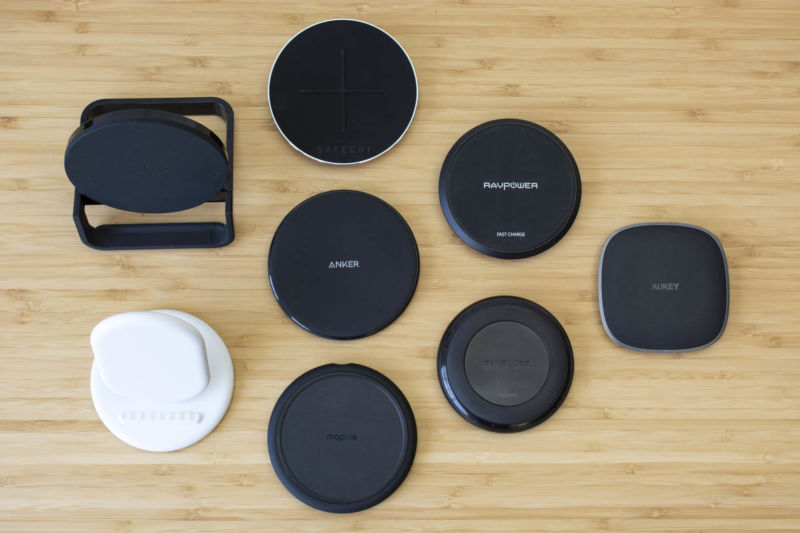
Wireless charging has a long way to go before it replaces wired charging, but the technology has advanced dramatically in the past few years. Everyone with the newest smartphones, wearables, and other gadgets can get behind the idea—simply place your device on a charging pad or stand and let it sit. Within a few minutes, you’ll have more battery power than you did before, and you didn’t have to fuss with wires or cables to get it.
But quite a bit of technology goes into make an accessory that makes your life that much easier. Most wireless chargers come in the form of circular or rectangular pads, some of which are propped up on legs to make stands that take up minimal space and work well as nightstand or desk accessories. But don’t be fooled by their minimalist exteriors—there are a number of things you should know before investing in a wireless charging pad. To navigate this murky world, Ars tested out some of the most popular devices available now to see which are worth buying.
How does wireless charging work?
Modern wireless chargers for smartphones use inductive charging to transfer energy between the charging pad and a mobile device. A loop of coiled wires sits inside the charging pad with a magnet in the center. As electric current passes through these wires, it creates an electromagnetic field around the magnet. That field can then transfer energy to a nearby receiver coil that’s found in smartphones and other mobile devices that support wireless charging.
The amount of power that can be transferred from the inductor (the charging pad) to the receiver (the mobile device) is dependent on many things, including the number of wire coils in both devices, the strength of the magnet in the inductor, and the distance between the inductor and the receiver. The latter explains the design of most wireless chargers today: smartphones need to sit very close to (i.e., directly on top of) the wireless charger to receive the most amount of energy possible.
Qi standard and your smartphone
Within the past couple of years, the Qi (pronounced “chee”) wireless charging standard has emerged victorious over other competing standards. At the start of 2018, Powermat, which pushed the PMA charging standard, joined the Wireless Power Consortium, the organization that represents the Qi standard. Powermat’s CEO stated at the time that Qi had become the “dominant wireless charging standard on the market,” and it only continues to exert its dominance by pushing other standards out of the game.
Knowing that a wireless charging pad follows the Qi standard simply means knowing that it uses Qi’s method of inductive power transfer and that it will power Qi-friendly smartphones. All Qi “base stations” (charging pads, stands, etc.) derive energy from a power source (typically an outlet) and activate only when a Qi-compatible mobile device has been placed on it. The base sends test signals to the device to ensure that it’s compatible, and once it has confirmed this, it starts inductively transmitting power to the receiving mobile device.
The underlying goal of Qi’s wireless charging technique is to power the compatible mobile device only to 100 percent. The receiving device and the base constantly communicate through signals that tell the base how much more power is necessary to power the mobile device’s battery in full. Once that’s achieved, the base essentially goes into standby mode, automatically stopping its transfer of power.
All of the wireless charging pads we’ve tested in this guide are Qi-compatible, so you’ll need a Qi-compatible smartphone to use them. Many recent flagship smartphones including the iPhone 8, iPhone X, iPhone XS, Galaxy S10, and Pixel 3 support Qi-wireless charging. If you have a smartphone that came out in the last two years, it probably supports wireless charging through the Qi standard.
But you can’t just throw your smartphone onto the charging pad and expect it to be powered up when you return hours later. Most Qi chargers follow the “guided positioning” principle, which means that the mobile device needs to be precisely placed on the pad so that its internal receiving hardware is lined up with the coiled wires and magnets that live in the charging pad.
So if your phone lands even just a few millimeters off of the intended placement, it may not charge while sitting on the base. Qi charging pads employ a few tricks to help users position their devices correctly, like visual and tactile design elements. Some bases even have internal coils that move to align with a user’s mobile device.
Wired or wireless charging?
If your top priorities are speed and efficiency, you should stick with wired charging. Plugging your smartphone into a charging cable that’s connected to a power outlet will almost always charge your device faster than a wireless charging pad. By its nature, wireless charging technology isn’t as efficient as wired charging, so you will not see the same rate of energy transfer that you would when charging with a wire.
However, wireless charging can be more convenient. Whether you have a charging pad or a stand, it’s easy to set your smartphone down and come back a little while later to a topped-up device. That’s why wireless charging pads are popular accessories for bedroom nightstands and office desks—they leave the environment free from messy cables while still providing a convenient method of charging your mobile device.
But wireless charging has hardware and software limitations. Be sure to check the wattage of your wireless charger and the compatible wattage on your smartphone. For example, iPhones running the latest version of iOS support 7.5W wireless charging. Even if you have a 10W charger, the iPhone will max out at 7.5W of wireless charging. While Apple has vaguely described faster wireless charging capabilities (up to 10W) in the iPhone XS and XS Max, there’s no official documentation or details to support this.
A note about Qualcomm Quick Charge
During our testing, Qualcomm announced it began working with the UL and Wireless Power Consortium to officially bring its Quick Charge technology to Qi-compatible wireless chargers. Not only does Qualcomm want to do this because the industry is slowly shifting away from wired charging, but it also wants to make it clear which devices support Quick Charge and which do not (some devices falsely claim to support the technology now).
These plans are still in the works, so we’re eager to update this guide when more Qualcomm-approved, Quick Charge-capable devices become available. Some of the devices we tested for this guide claim “fast charge” capabilities, but we mostly ran our tests (see below) to judge just how quickly each device could charge a smartphone.
How we tested
We tested some of the most popular wireless chargers on the market and judged them based on design, power, price, and charging efficiency. To benchmark each charger, we used a few smartphones: iPhone XS, iPhone XS Max, iPhone XR, Google Pixel 3, and the Samsung Galaxy Note 9. Before testing each charger, we powered up each smartphone from 0 percent battery life using its included charging cable to obtain standard charging reference points. We then ran the following tests three times per smartphone and averaged the data to get a final score.
- One-hour charge: Charge smartphone wirelessly for one hour, starting at 0 percent battery, and record the result in percentage-charged.
- Full battery charge: Charge smartphone wirelessly, starting at 0 percent battery, until battery level reaches 100 percent, and then record the result in minutes-charged.
If a wireless charging pad came with an AC adaptor, we used that adapter in our testing. If a pad didn’t come with an AC adapter, we used the Anker Dual USB PowerPort II 24W Charger along with the cables provided with the device (every wireless charging pad we tested came with a cable). In addition to charging percentage and time, we also recorded the temperature of each smartphone after it was fully charged using the Etekcity Lasergrip 774 Digital Laser Infrared Thermometer.























